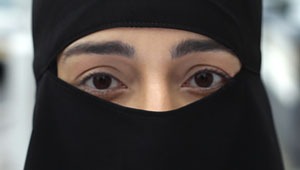 In his short film “Khaana,” director Cary Rajinder Sawhney follows a young pregnant Muslim woman with a voracious appetite for food and life. Sawhney was formerly Head of Diversity at the British Film Institute and has written about British-Asian cinema. “Khaana” won the Best Short Film award at this year’s New York Indian Film Festival. We talked to Sawhney on the red carpet just before the awards were announced on Saturday.
In his short film “Khaana,” director Cary Rajinder Sawhney follows a young pregnant Muslim woman with a voracious appetite for food and life. Sawhney was formerly Head of Diversity at the British Film Institute and has written about British-Asian cinema. “Khaana” won the Best Short Film award at this year’s New York Indian Film Festival. We talked to Sawhney on the red carpet just before the awards were announced on Saturday.
I was at the screening [last Friday] and it seemed like the audience really responded to the film.
It was a really nice vibe and people really seemed to enjoy the film. And I was surprised because you never know how people will take to it — I mean, it’s only eight minutes — but it was really cool.
You’ve said that the film’s plot is inspired by a poem?
It’s inspired by a poem by Anjum Malik, a poet from Manchester [England] and also by the films of Satyajit Ray, who I am a really big fan of.
During the Q and A after your screening, you mentioned that Muslim identities and South Asian identities have really evolved in the UK in recent years.
I think that as immigrants we are going in lots of different directions at the same time, like all of us here [in the U.S.], it’s the same in New York, I guess. In Britain it’s relatively easy going and you can do whatever you like. So recently there’s a whole cultural change that I think is reflected in the film. For example, the back story, the mother in this film is less orthodox than the daughter — the daughter is more orthodox than the mother, who is wearing less traditional clothes. Because that’s happening more where the children are adapting a socially and culturally more conservative identity than sometimes the parents are. You see lots of girls in hijab now and you wouldn’t have seen that 10-15 years ago.
After the Iraq war and the London bombings, a lot of people felt that they were being challenged and instead of hiding away they decided to be more traditional. Which is brave and I thought that I wanted to show how it’s almost fashionable for girls to wear hijab now, which is interesting.
Do you see yourself revisiting these characters in the future and making a feature-length film?
Maybe. I’ve got loads of stories that I want to explore.












